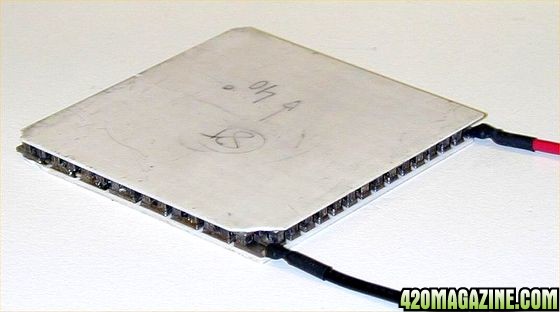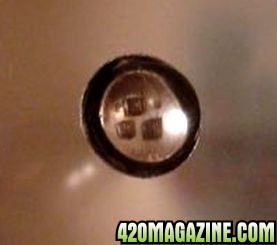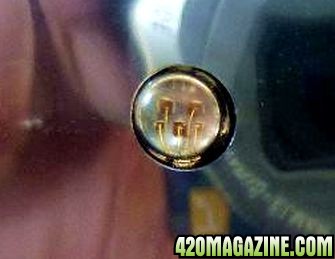Plants're starting to look good under those mother f'n hot LEDs there,
Sun...

Lurker- thanks for the referral to this journal. More of information like this and less of some of the other stuff and we all might learn what really works with these LED's and what doesn't. Good for everybody...
...Thanks for your post in this forum- I could not and would not disagree with a single word in it.
Well heck
astro^2, I'm honored sir. Couldn't have asked for a more ringing (or timely) endorsement than that, especially considering your pedigree.
I just call 'em like I see 'em. If it's good I say so - and if it smells funny, I hold my nose...

And as for the manufactures of LED dies- Philips Semi, Cree, Bridgelux, Seoul Semi, Nichia, etc, etc- all playing the same game with watt ratings. You can see the header at the top of the Philips data sheet- the data as shown assumes a pad temperature of 25C-...You would need some kind of impractical, out of this world cryo cooling unit to keep the pad at 25C. Guess what happens when the pad gets this hot- all of the things you mention in your post!!!
Very true, I see it kind of like the difference between
in vitro and
in vivo results in biological systems. In the real world you're never going to get a 25C thermal pad temperature, at least practically speaking. The dies are certainly more efficient underneath of that temperature (esp. the reds) since lumen output is on a non-linear curve (or rather, a near-linear curve that is also thermal self-limiting). But it's not good for plants if the room's also
-20C!!!
I've seen die tests done where the emitters were intentionally ramped up and cooled with homemade
Peltier (TEC) devices; it certainly improved the emitter efficiency (and kept the die from melting!), though not in a total-system sense. (And cranking a 2200 lumen Bridgelux to 4000+ lumens at
205F with cooling is not exactly long-life friendly!

)
-----------------
I have thought about DIYing a small unit to try it out, though.
These Guys make
custom TECs in addition to the standard CPU/GPU ones (you can find them cheaper elsewhere, in standard packages, but the made-to-order stuff is cool - and they'll do small quantities, too). As overall LED efficiency goes up with each manufacturing line introduced into the market, maybe not unheard of in the near future. It would certainly help with all the things we talked about earlier.
(Standard CPU TEC module w/ceramic top/bottom)
Since a good % of what goes to the LED gets converted to light, we're only really concerned with getting rid of the energy that doesn't - i.e. moving enough Deg. C off the die to keep it closer to norms (of maybe a 40-45C difference w/o TEC). That could mean a
pretty big jump in lumen efficiency, esp. with
reds.
Of course, this means if you're moving, say, ~15W away from the MCPCB, the heatsinks/fans have to get rid of an extra 40-45W+ on the other side (the 15W you removed, and ~25-30W+ from I2R (heat) losses from TEC). So more
total power is used, but it reduces/eliminates many of the heat issues from the backside of the actual dies.
Efficient? Probably not. Doable? Yes.
Cool? Absolutely! :icon_cool (no pun intended)
From an absolute power (and $/watt) standpoint, it's certainly more practical to use wider spacing between LEDs, bigger heatsinks, higher CFM fans, and simply
more LEDs if you want higher PAR, though (but perhaps not higher irradiance within a very small area - which isn't really necessary anyway, IMO. Putting 300-600W in such a small (light board) profile simply
wastes energy. Only so much plant biomass can grow into any particular area. See those
Mythbusters results...)
An interesting introduction/workup for folks on
practical Thermoelectric Cooling for computers can be found. Some nice charts and graphs and a summary on when/whether it makes sense to use them, or not. Same general rules apply to LEDs of course...
If the overclockers can take a 100W+ CPU and keep it
under freezing temperature this way, I'm sure mild-to-moderate TEC over a larger area would be useful, too. As long as you take the proper steps to get rid of the extra heat...
Pretty easy to do a modular LED/Peltier setup and then
put them together any way you want. Imagine having standard module sizes
you can just snap together, and add drivers as and where they're needed. Like high-tech LEGOs for adults!

...now, you run 700mA thru a 1mm^2 LED die and this pad is going to be 'smoking a$$ mother effing hot' (that is an engineering term, don't be offended)....
The red dies (AlInGaP) are much worse in all performance aspects than the blue dies (InGaN)- lots of reasons for this- which I would love to talk about in length, but maybe another time.
He he...I think we've had the same professors.

Here's a definition I took directly from my Swipe File (in the Appendix):
(3) A Shitload: According to a reliable source from MIT's Engineering department, 'A Shitload' is a technical term for a quantitative unit of measurement that falls somewhere between 'A Lot' and 'A F**kload'. While not exactly finite, A Shitload is still considered to be quite substantial…
As for the red dies, I figure part of the (non Physics-based) reason is manufacturers have been chasing the
150 lm/w target for white (InGaN phosphor-coated) LEDs for general purpose lighting. Now that Cree's hit that, and that level will become more commonplace in the next couple of years in a lower price point, maybe we'll start to see renewed focus on color LEDs...and adding red LEDs to cooler (CRI-rated) whites to approximate 'warm' white in purpose-built fixtures for the home, using color blending.
The
Neutral White (4000K) LEDs have definitely gotten better efficiency-wise (> 100 lm/w) in the last couple of years, also. I'd consider using them instead of cool whites (6500K) in multi-spectrum panels at this point,
for many reasons...
Hey Sun- on page 8 you have a shot of the fixture. Well it is a 'b' to get old- I cannot for the life of me determine what kind of LED devices these are- old eyes. Can you post a little closer shot one of these things. I can clearly make out the white LED's (yellow) and that's about it- I cannot make out the device package.
Looks like Sun posted a close-up pic a page or two back, take a look and see what you think. I enlarged another pic from my data files for you; here they are:
First pic is from my files, second is an enlarged version of a package from SS's shot that I digitally enhanced/scrubbed in Photoshop; you can see the
copper leads to the individual dies/chips in that one.
Would love to get your thoughts on those, also,
astroastro...
...Regarding the potential eye hazards- there is a pretty good paper that describes these issues-
The bandwidth required to satisfy the photosynthetic needs of the light harvesting complexes are about smack dab in the middle of the 'danger' curve on page 5. I have a theory on this and how it relates to LED grow lights but maybe too kooky for this forum.
Thanks also for this paper. Great that we have a nm peak for Chlorophyll that's exactly at its max for photochemical retinal eye damage, too...

Hey mate,
no theory is too kooky for this forum! 
I used to live in Asia and have heard some pretty strange ones myself. No one's going to judge you here. Go ahead and spill the beans--!

(At least, PM me with it if you're still feeling reticent...I'd like to know!)
Cheers,
-TL







 Here's a definition I took directly from my Swipe File (in the Appendix):
Here's a definition I took directly from my Swipe File (in the Appendix):


 I used to live in Asia and have heard some pretty strange ones myself. No one's going to judge you here. Go ahead and spill the beans--!
I used to live in Asia and have heard some pretty strange ones myself. No one's going to judge you here. Go ahead and spill the beans--! 

